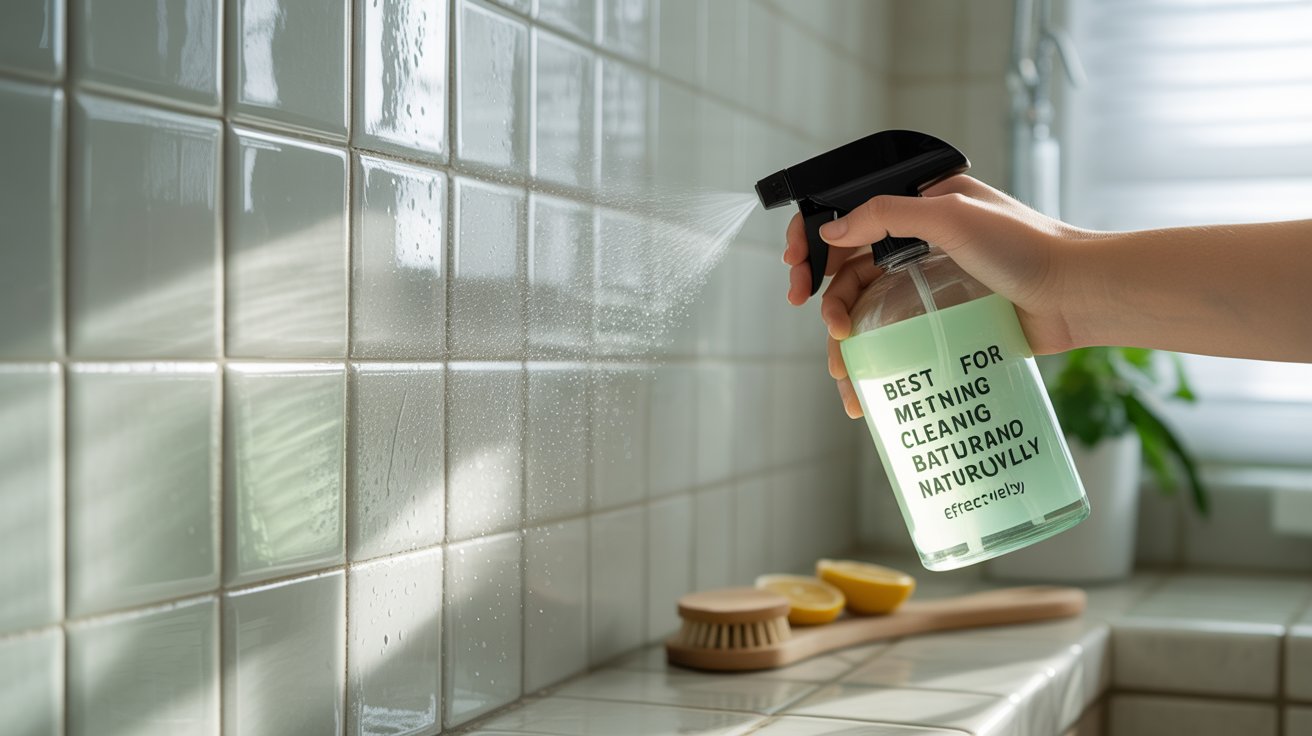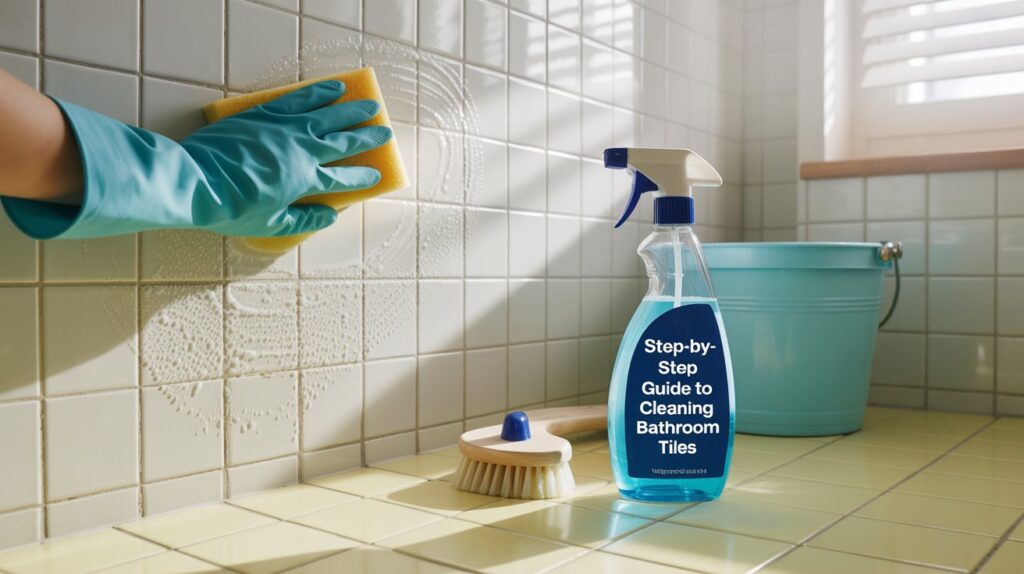
Introduction:
Cleaning bathroom tiles is one of the most important steps in keeping your bathroom looking fresh, hygienic, and inviting. Over time, tiles can collect soap scum, hard water stains, and mildew, making your space appear dull and dirty. With the right methods and regular maintenance, you can easily restore their shine and prevent buildup. In this guide, you’ll discover effective tips, common mistakes to avoid, and the best techniques for keeping your tiles spotless all year round.
Table of Contents
Why Regular Tile Cleaning Matters
Regular cleaning bathroom tiles is essential not only for maintaining a spotless appearance but also for promoting a healthy environment in your home. Over time, soap scum, hard water stains, and mold can build up on tiles and grout, making your bathroom look dull and unhygienic. By cleaning your tiles frequently, you can prevent these problems before they become difficult to remove.
Keeping up with bathroom tile cleaning also helps extend the life of your tiles. Dirt and grime can slowly damage the surface, causing discoloration and weakening grout lines. Regular maintenance ensures your tiles stay shiny, smooth, and protected from long-term wear and tear.
Another key reason to prioritise cleaning bathroom tiles is to prevent the growth of mild and mildew. Bathrooms are humid spaces, making them ideal for bacteria and fungi to thrive. Proper tile cleaning and ventilation reduce moisture buildup and keep your bathroom smelling fresh and safe for your family.
Lastly, clean tiles contribute to the overall beauty of your bathroom. A well-maintained, sparkling surface creates a more relaxing and welcoming space — something every homeowner appreciates.
Common Issues When Cleaning Bathroom Tiles
Even with the right tools and effort, cleaning bathroom tiles can come with a few challenges. Understanding these common issues can help you avoid damage and achieve better, longer-lasting results.
1. Soap Scum and Hard Water Stains
One of the most frequent problems when cleaning bathroom tiles is dealing with soap scum and mineral buildup. Hard water leaves behind calcium and lime deposits that make tiles appear cloudy or dull. If not removed regularly, these stains can become difficult to clean and reduce the shine of your tiles.
2. Mold and Mildew in Grout Lines
Bathrooms are often warm and humid, creating the perfect environment for mold and mildew growth. These can form in the grout between tiles, causing dark discoloration and unpleasant odors. Regular cleaning of bathroom tiles and grout helps prevent these health-harming organisms from spreading.
3. Using the Wrong Cleaning Products
Some cleaners contain harsh chemicals that can damage the tile surface or erode the grout. When cleaning bathroom tiles, always choose gentle, non-abrasive cleaners or natural solutions like vinegar and baking soda. This helps maintain the durability and finish of your tiles.
4. Slippery Surfaces After Cleaning
If tiles aren’t rinsed properly, leftover cleaning residue can make them slippery. This not only dulls the shine but also creates a safety risk. After cleaning bathroom tiles, always rinse with clean water and dry the surface thoroughly to prevent slips.
5. Ignoring the Grout
Many people focus only on the tile surface and forget the grout. Dirty grout can make even clean tiles look stained and unattractive. Regularly scrubbing and sealing the grout is an important part of effective bathroom tile cleaning.
Best Methods for Cleaning Bathroom Tiles
Keeping your bathroom tiles spotless doesn’t have to be difficult. With the right methods, you can easily remove dirt, soap scum, and stains—without damaging the surface. Here are some of the best methods for cleaning bathroom tiles effectively and safely.
1. Regular Cleaning with Warm Water and Mild Soap
For everyday maintenance, a simple mix of warm water and mild liquid soap works wonders. Dip a soft sponge or microfiber cloth in the solution and gently scrub the tiles. This removes surface dust and prevents grime buildup.
2. Deep Cleaning with Vinegar and Baking Soda
When tiles start to lose their shine, it’s time for a deep clean. Mix equal parts of vinegar and water in a spray bottle and apply it to the tiles. For extra cleaning power, sprinkle baking soda first and then spray the vinegar solution. Let it fizz for a few minutes before scrubbing gently with a brush.
Why it works:
Vinegar dissolves soap scum and hard water stains, while baking soda removes grime without scratching.
3. Cleaning Grout Lines
Grout lines often trap dirt and mild, making your tiles look dull even after cleaning. Make a paste using baking soda and water, apply it to the grout, and scrub with an old toothbrush. For deeper stains, use a little hydrogen peroxide for whitening
Tip: After cleaning bathroom tiles and grout, seal the grout every few months to prevent moisture buildup.
4. Steam Cleaning for a Chemical-Free Option
If you prefer a natural method, steam cleaning is an excellent choice. A steam cleaner uses high-temperature steam to loosen dirt, kill bacteria, and sanitise tiles without using any chemicals.
Why it’s great:
It’s eco-friendly, safe for most tile types, and perfect for deep cleaning hard-to-reach areas.
5. Preventive Maintenance Spray
To keep your tiles looking clean longer, make a preventive spray using equal parts vinegar and water with a few drops of essential oil. Spray it on tiles after every shower and wipe lightly. This prevents soap scum and mildew from forming.
Key Takeaway:
The best methods for cleaning bathroom tiles are consistent, gentle, and chemical-free. Regular cleaning, combined with occasional deep scrubbing and preventive care, helps maintain their shine and extends their lifespan.
Step-by-Step Guide to Cleaning Bathroom Tiles
Keeping your bathroom tiles looking spotless doesn’t have to be complicated. By following the right steps, you can remove dirt, grime, and stains effectively—without damaging your tiles. Here’s a simple step-by-step guide to cleaning bathroom tiles that will help you achieve a lasting shine.
Step 1: Gather Your Cleaning Supplies
Before you begin, make sure you have all the tools and ingredients ready. You’ll need:
- A bucket of warm water
- Mild liquid soap or vinegar
- Baking soda (for tough stains)
- A sponge, soft brush, or old toothbrush
- A microfiber cloth for drying
Tip: Having everything ready saves time and keeps your cleaning process efficient.
Step 2: Remove Loose Dirt and Dust
Start by sweeping or wiping down the tiles to remove dust, hair, and loose debris. This prevents scratching when you begin scrubbing.
Step 3: Apply Your Cleaning Solution
Mix equal parts of vinegar and warm water in a spray bottle or bucket. Spray or spread the solution evenly across the tiles, especially where soap scum or stains are visible. Let it sit for 5–10 minutes to loosen dirt and buildup.
Step 4: Scrub the Tiles and Grout
Use a soft brush or sponge to scrub the tiles in circular motions. For grout lines, dip an old toothbrush in a baking soda paste (baking soda + water) and gently scrub away dirt and mildew.
Step 5: Rinse Thoroughly
After scrubbing, rinse the tiles with clean water to remove any residue from vinegar or soap. This helps prevent streaks and slippery surfaces.
Step 6: Dry the Tiles
Use a microfiber cloth or a dry towel to wipe down the tiles. Drying prevents water spots and helps maintain a shiny finish.
Step 7: Regular Maintenance
To keep your bathroom tiles looking fresh, make cleaning bathroom tiles a weekly habit. Use a daily spray after showers to prevent soap scum and mold buildup.

Key Takeaway:
By following this step-by-step guide to cleaning bathroom tiles, you can maintain a bright, hygienic, and slip-free bathroom with minimal effort. Consistent cleaning keeps your tiles looking new and prevents long-term damage to grout and surfaces.
Tips to Keep Bathroom Tiles Clean Longer
After putting in the effort of cleaning bathroom tiles, the goal is to keep them looking fresh and spotless for as long as possible. With a few simple habits and preventive measures, you can reduce buildup, prevent stains, and make your next cleaning session much easier.
1. Wipe Down Tiles After Every Shower
Moisture is one of the main reasons tiles get dirty quickly. Use a squeegee or microfiber cloth to wipe away water droplets after each shower. This helps prevent soap scum, mildew, and water stains from forming.
2. Use a Daily Spray Cleaner
Mix equal parts vinegar and water in a spray bottle and lightly mist your tiles after using the shower. This simple habit slows down grime and mold buildup, extending the results of your last deep clean.
3. Keep the Bathroom Well-Ventilated
Humidity encourages mild and mildew growth. Keep your bathroom fan on for 15–20 minutes after showers, or open a window to allow proper air circulation. This prevents excess moisture from clinging to your tiles and grout.
4. Clean Grout Regularly
Even if the tiles look clean, dirty grout can make your bathroom appear dull. Scrub grout lines once a week using a baking soda paste or a gentle grout cleaner. Keeping grout clean enhances the overall look of your tiles.
5. Avoid Harsh Chemical Cleaners
Strong chemicals can wear down tile surfaces and grout over time. When cleaning bathroom tiles, stick to gentle or natural solutions like vinegar, baking soda, and castile soap. They’re safe, effective, and environmentally friendly.
6. Place Mats or Rugs Near Wet Areas
Put absorbent mats near the bathtub, shower, or sink to catch splashes and reduce water stains. This small step can go a long way in keeping your floor tiles cleaner for longer.
7. Schedule Deep Cleaning Once a Month
Even with regular maintenance, a monthly deep clean helps remove buildup and keeps tiles shiny. Use your preferred method for cleaning bathroom tiles—natural or chemical—for a complete refresh.
Key Takeaway:
Keeping your tiles clean is about consistency, not effort. By combining daily habits like wiping and ventilating with monthly deep cleaning, you’ll make cleaning bathroom tiles easier and maintain a spotless, hygienic bathroom all year long.
Common Mistakes to Avoid When Cleaning Bathroom Tiles
Even with the best intentions, many people make simple errors that can damage tiles, weaken grout, or make cleaning less effective. By avoiding these common mistakes, you can keep your tiles looking new and extend their lifespan. Here’s what to watch out for when cleaning bathroom tiles.
1. Using Harsh Chemical Cleaners
Strong chemicals like bleach or ammonia might seem effective, but they can wear down tile finishes and erode grout over time. Instead of using harsh cleaners, opt for natural or mild solutions such as vinegar, baking soda, or castile soap. These are safer for both your tiles and your health.
2. Scrubbing with Abrasive Tools
Using steel wool, hard brushes, or rough pads can scratch the tile surface, especially on ceramic and porcelain. When cleaning bathroom tiles, use a soft sponge, microfibre cloth, or non-abrasive scrubber to avoid damage.
3. Ignoring the Grout
Grout often collects more dirt and mould than the tiles themselves. Many people focus only on the tile surface, leaving the grout untreated. Make sure to clean grout lines with a baking soda paste or grout cleaner regularly to prevent discolouration and mould growth.
4. Not Rinsing Properly
Leaving soap or cleaner residue behind can make tiles slippery and attract more dirt. Always rinse thoroughly with clean water after cleaning bathroom tiles, and dry the surface with a microfibre cloth for a streak-free shine.
5. Skipping Regular Maintenance
Waiting too long between cleanings allows soap scum, mould, and mineral buildup to harden—making them harder to remove later. A quick weekly wipe-down helps maintain clean, shiny tiles without extra effort.
6. Using Too Much Cleaner
Applying too much product doesn’t improve results—it just creates more residue to rinse off. When cleaning bathroom tiles, a light spray or small amount of cleaner is enough. Overuse can dull the shine or leave sticky streaks. Key Takeaway:
The secret to effectively cleaning bathroom tiles is using the right tools, gentle cleaners, and consistent habits. Avoiding these common mistakes helps preserve the beauty of your tiles and keeps your bathroom looking fresh and polished for years.
Conclusion
Keeping your bathroom spotless doesn’t have to be difficult — it just requires the right approach. Regularly cleaning bathroom tiles helps prevent buildup, protects grout, and keeps your space looking bright and hygienic. By using gentle cleaning methods, avoiding harsh chemicals, and following smart maintenance habits, you can save both time and effort in the long run.
Whether you choose natural solutions or commercial products, consistency is key. A few minutes of care each week will go a long way in maintaining the shine and durability of your tiles. Make cleaning bathroom tiles part of your regular routine, and enjoy a cleaner, fresher bathroom every day.
FAQs About Cleaning Bathroom Tiles
To help you get the best results, here are answers to some of the most common questions people have about cleaning bathroom tiles.
1. How often should I clean bathroom tiles?
For best results, clean your tiles at least once a week. Regular maintenance prevents soap scum, mould, and mildew buildup. A quick daily wipe-down after showers can also make weekly cleaning much easier.
2. What is the best natural solution for cleaning bathroom tiles?
A simple mix of vinegar and water works great for removing grime and stains naturally. For tougher spots, sprinkle baking soda on the surface before spraying the vinegar solution—it creates a gentle fizzing action that lifts dirt.
3. Can I use bleach for cleaning bathroom tiles?
Bleach can be effective for disinfecting and whitening grout, but it should be used sparingly. Frequent use can weaken grout and dull your tiles. If you prefer a safer option, use hydrogen peroxide or natural cleaners instead.
4. How do I prevent mould and mildew on bathroom tiles?
Keep your bathroom well-ventilated by turning on the exhaust fan or opening windows after showers. Wipe down tiles to remove excess moisture and spray a light vinegar solution weekly to keep mould away.
5. What tools should I use for cleaning bathroom tiles?
Use a soft-bristled brush or microfibre cloth to avoid scratching the surface. For grout, a toothbrush or grout-specific brush works best. Avoid metal scrubs.bers or abrasive pads that can damage tile finishes.
6. How can I make tiles shine after cleaning?
After cleaning bathroom tiles, rinse them with clean water and dry them using a microfiber cloth. You can also buff them with a little white vinegar or a few drops of essential oil mixed in water for extra shine.
Key Takeaway:
Understanding the right techniques and tools for cleaning bathroom tiles ensures lasting results. With regular care and gentle products, your bathroom tiles will stay sparkling clean and fresh without extra effort.
